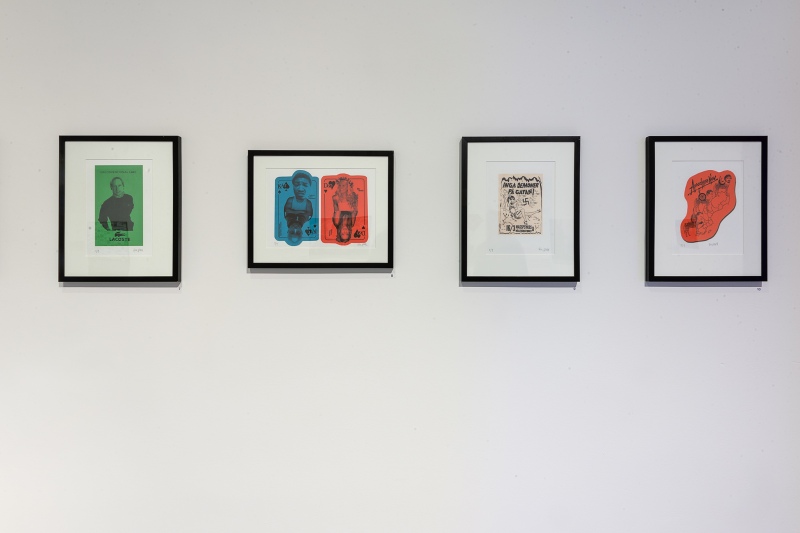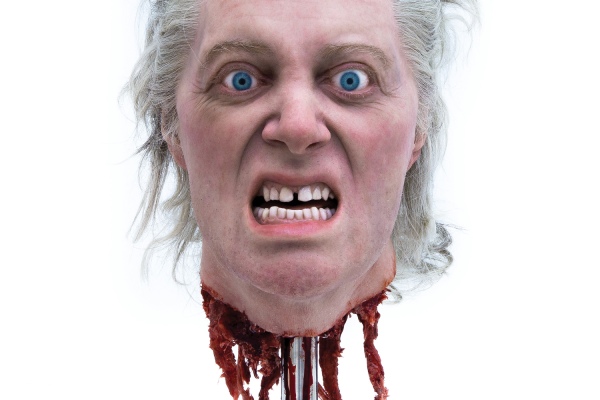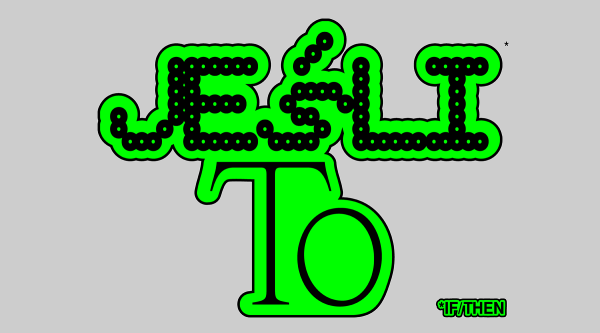Jon Eirik Lundberg
Unwanted Warnings. On the Scandinavian reception of Dan Park’s collages
The Swedish street artist Dan Park is perhaps the most disgraced person in all of Scandinavia. He was convicted twice to time in prison for inciting hatred against an ethnic group.
The sentences were based on a decision by the Swedish court not to interpret images based on lack of competence. Thus the courts ignored the context and content of the collages in question, and assessed them, as they claimed, solely based on the initial, immediate layer of each image. This claim can be philosophically questioned. Is it even possible for a human being to block his or her own mind from interpreting sensory data? The answer is probably no, since it would demand two minds separate from one another, with one having the power to command it. And more than that: Since the decision is taken at a certain point in time after seeing the images, the decision “second mind” would also need to have the power to “erase” the interpretative processes that have already taken place in the “first mind.” Altogether, this constitutes a fundamentally flawed basis for the sentences, which are thus founded in power rather than in truth. In this particular situation, one cannot definitely rule out the possibility that political opportunism influenced the court’s ruling.
Dan Park has declared that since most street art in Sweden deals with left wing themes, he will explore a contrary thread, bringing a right wing angle to issues in Swedish society. This has resulted in the opinion that Park is “right wing” himself. His collages contain images and texts, the latter often in the form of utterances or statements, which are most often attributed to Park. Such claims regarding him being the author of these statements and his political preferences are supported by information on Park’s whereabouts in his private life. He has been photographed at a concert where there were Swedish neo-Nazis present and next to another such person at some party. This information was brought to the attention of the public by the “secret service” of the Danish left wing extremist group Antifa, Redox. The latter brands itself as a “research collective” but over the years it has amassed an archive of individuals they consider political enemies. Some of these individuals are terrorized in their own homes and later offered “exit programs”. This modus operandi imitates how the government, namely the police, treats extremists. Redox places photographers at entrances to conferences on, for example, the freedom of speech, in order to intimidate the guests and deter them from coming again. Redox is the prime source on the narrative of Dan Park “being a Nazi”. Their archive contains thousands of names of other “Nazis”, who are regular citizens attending conferences on issues that concern them, exercising their right to freedom of assembly, thought and speech. Redox apparently does not respect these rights, and seeks to take them away from the people. They have established their own, parallel political order – this is called ‘sedition’ and in pre-modern times, people accused of sedition would be sentenced to death.
Given the nature of Redox, the accusations against Park and his relations to “Nazis ideology” must be critiqued. It is impossible to treat Redox as an accurate and neutral source of information.
In my view the sum of these entire accusations amounts to a distorted interpretation of Dan Park’s works, which may suggest the influence of a certain political agenda.
I will briefly confront the first set of assumptions concerning Park’s personal political orientation. It is evident from Park’s entire oeuvre, ever since his youth, that first and foremost he is an “anarchist of opinion”. It is also a fact that some branches of metal music attract extremists of all kinds of political views, both “left” and “right”. These terms are, however, not to be confused with the separation between the left and right in the context of parliamentary politics. In principle, there is no connection between political parties and violent, totalitarian sects. A left wing party is as much of an enemy to a left wing extremist as a right wing party can be. And visa versa. That being said, it should be noted that these groups present a danger to society and they do all they can to disrupt the social order. What is more, they also threaten individuals they consider enemies. Still, the boundary between these groups and the music scene can be blurry. Being seen at such events does not in itself define any individual’s political orientation.
It is also true that none of those who have concluded on Park’s political life have ever asked him what he thinks. I have had the opportunity to ask him to answer 30 standard questions in a formula designed to identify which candidates the voter is most aligned with – it turned out that Park has the most in common with candidates from two left wing parties.
Of course this is not a scientifically valid approach to any phenomenon, but then again this problem is not scientific in nature. When it comes to Park’s political views I see no option but to conclude that he is who he identifies himself as: an anarchist in regards to the question of power, otherwise leaning on the values of the culturally Christian society he grew up in.
I also think this is visible in his collages; as long as one is willing to see in them [Park’s] suffering consciousness.
Dan Park’s collages often contain warnings directed at the public, presented in a direct and unapologetic manner. He ironizes over certain ideas, for example that it is always good to “fight the power”, to be idealistic, or to envision a new society. In other words, he criticizes a revolutionary sentiment and warns against the dangers of utopianism. His collages also expose blind spots in the anti-racist struggle, especially when it fails to confront racism between minorities. This blind spot leaves individuals exposed to the very dangers the anti-racist struggle officially should prevent. And this is probably where anger against Park is rooted: When well-meaning people who think they are doing the right thing are told they are responsible for the evil, they seek to destroy the messenger.
In order to illustrate this point, I will discuss three examples.
The first is a collage combining a photograph of Anders Behring Breivik, the ill-famed Norwegian terrorist, and the slogan “Fight the power”. As I interpret the image Breivik is saying, “Fight the power”. Breivik grew up in a politically active family; both his parents were members of the Norwegian Labour Party. According to some, the mentally ill Anders was driven by an intense hatred towards his father, who refused to see him, and therefore launched an attack on everything his father – a career diplomat and party member – stood for. To say that the Labour Party “is the power” would not be totally wrong – the party dominated Norwegian politics for decades after the Second World War. At the same time, “fight the power” is a slogan of the left – it could easily be a slogan for large swaths of the Labour Party. It describes a worldview that is common on the Scandinavian left – the bourgeois society is the enemy. This has led to decades of daily, routine condemnation of Israel and the USA. During his trial, Breivik described his own acts as “cruel but necessary”. This phrase captures the logic of the Maoists – “you cannot make an omelette without breaking eggs.” Breivik also claimed to have “sacrificed himself” while killing others; a distorted inversion of chronology that one can find in all totalitarian movements – not just the Nazi’s claim that they, the Aryans were “encircled by Jewry” and thus acted in “self-defence” when attacking Jews. The misplaced “fight the power” slogan uttered by Breivik thus portrays the principally confused understanding of totalitarianism. It resembles Adolf Eichmann’s final words: “Long live Germany long live Argentina long live Austria. I shall not forget them” after which he was hanged. The phrase is usually said by the living to the dying. Park’s collage also places Breivik on the side of the people whom he attacked. This may seem extremely offensive, but historically such twists of events are not uncommon in political religions. The Communist Party of the Soviet Union (CPSU) purged it’s own loyal and dedicated members, accusing them of treason. In their defence these members could say: “But I am a loyal and dedicated party member!” To which the political police (NKVD) would answer: “If you really mean that, then you must give the Party the concession it is asking for.” Then, they would be executed for crimes they never committed. The collage brings the deep distortions of totalitarianism to the surface. It also says that one should not embrace the slogan “Fight the power” uncritically.
At first sight, the second piece is exceptionally upsetting and shares some of the qualities I describe above. It shows Adolf Hitler holding a speech. This time the slogan is: “Not only (the n-word in plural) have dreams”. Because of the n-word, it is almost impossible to see/view this artwork – it clearly violates all norms of communication. But like Nietzsche, Park may be “teaching with a hammer” – he is not trying to convince the viewer, but to keep the viewer “awake.” But let us put this poisonous term aside for a moment. The image says: “dreams of ‘a new society’ may be extremely dangerous for the population. Martin Luther King dreamt of normality and the collage is not criticizing that, but is directed towards the utopian fantasies of different branches of socialism. In a double insult, Park places Hitler alongside the other members of the socialist “family” – that is, among others who have dreamt of a new world and a new Mankind: Stalin, Lenin, Mao, Castro, etc. They committed crimes of a comparable, or even bigger magnitude, than Hitler. This warning is thus a warning against all sorts of totalitarianisms, but it is conveyed through the words of a dream that has always been legitimate (normality). Park forces the viewer to differentiate Luther King from European ideologists, and thus places the European left wing on the wrong side of History. From this point of view, it is hardly difficult to see the source of hatred against Park.
The third example is the piece “Hang on afrofobians”. This was the collage that led to Park’s first prison sentence. It reiterates a terrible event that took place in Park’s hometown, Malmö. A man of African descent went to a playground with his one and a half years old son. For some reason, he got into a quarrel with a group of women. Shortly thereafter ten men arrived and attacked him. They beat him in front of his crying child, and then tried to throw him off a pedestrian bridge over a highway. Luckily the man survived the attack. For a week, the Swedish public was engaged in the case. The media portrayed it as a horrifying racist event, assuming that the perpetrators were white Swedish men. Suddenly a small blog exposed the fact that the men were Kurds, which led to an immediate news blackout on the case – it disappeared from the public sphere. This was because of a conviction that bad news involving people belonging to a minority can lead to racist attacks against other members of minorities. This belief has never been tested or proven, and it is somewhat a taboo even to discuss it. If you do not understand it, and therefore need to talk about it, you may be on the wrong side. And if you are on the right side, you have no need for discussing it. Park summarized the entire event in one collage. The pedestrian bridge is the central motive. Three heads are hanging in nooses suspended from the walkway – each has a name, all three belong to black men. One is the victim; the two others were active in the first week of debate, accusing the Swedish society of being racist. They both went silent after the revelation of the perpetrators’ ethnicity. The collage therefore says: racists can get away with being racist, as long as they belong to an ethnic minority. And this is obviously a dangerous situation. It means the failure of the institutions of the state. This reminds us of the context of the song Strange Fruit, first performed by Billie Holiday. At that time it was of course illegal to hang people at random. But this still happened to black men in the southern American states. The notorious hanging of black men constituted a state of emergency – state of anarchy. A governmental anti-drug agent decided to destroy Billie Holiday’s career due to that song, and he succeeded. He is now described as a racist, but that is secondary to the main point, I think: That he wanted to prevent Holliday from performing the song, and thus telling the truth about the state of emergency in the southern states. Park’s collage is pointing in the same direction: There is a domain in our society where the institutions are powerless. And where there is no power, there is violence, as Hannah Arendt observed.
The aftermath of the collage is intriguing. Once the case itself – the attack – was hushed, attention was brought to Park’s work instead. He was now accused of “inciting hatred towards a minority” – by showing the black men pictured in nooses hanging from the bridge. In fairness, it should be said that the picture is portraying precisely what it is warning against. It says, “This could happen if the current state of affairs is allowed to develop”. But as the case he is referencing has been shut down, the attention returns back to the collage. One of the persons in the picture accused Park of racism for showing him in a noose, and so the court case began. A demonstration against Park was arranged in Copenhagen, where the girlfriend and the son of the victim walked in the first line. There were no demonstrations against the perpetrators, who were never identified. They got away with it.
Now, a decade later, Sweden is riddled with violence and experiences killings on an almost daily basis. Fundamentally, none of those victims are ethnical Swedes.
The fourth and final example is an installation Park created in a public space close to the Synagogue in Malmö. At the time, the Jewish community was exposed to attacks from groups linked to the Palestinian cause. This problem has been manifest for years, but at this time there was unusual publicity around it. The Jewish community in Malmö has seen an exodus of members during recent years, with some moving to Israel in search for security. As is so often the norm in Sweden, the public communication from the government, indeed the Social-democratic Party, tends to minimize the problem and accuse those who address it for stirring up social unrest driven by hatred and racist motives. In the summer of 2021, the head of the Malmö police suggested members of the public should “think of other things” than the violence in the city. As the news of attacks on the Jews entered the public sphere, in a rather unusual moment of truth, Park commented in his usually harsh way.
He produced two objects, which were mounted on the reverse of a traffic sign near the Synagogue. One was a metal can labelled “Cyclone-B”. The other was a swastika made out of perler beads, a popular toy for kids, which can be found in homes and at kindergartens. The perler pegboards are closely associated with the concept “folkhemmet”, “the home of the people”; a Swedish concept describing the state’s responsibility for people’s wellbeing from birth to grave. The same state was a de facto ally of the Nazi regime, providing important raw materials (steel) for Hitler’s army and allowing German troops to pass through Sweden during the Nazi campaign against Norway. The Swedish king and elites largely favoured National Socialism. As the Norwegian royal family narrowly escaped the invading Nazi forces in 1940, the queen, who was Swedish, returned briefly to Stockholm, but she was unwelcome there, and moved on to England and America. The escaping royal family as a whole were denied entry to Sweden. Thus the swastika made out of a perler pegboard points to a discrete, but dreadful continuity – namely, the fact that the Swedish government is unable to protect the Jewish community in Malmö, and instead intimidates people trying to address the problem. The “Cyclone-B” can is a clear warning: “History has shown what this kind of thing can lead to”.
This is what is categorically forbidden to say in Sweden: that members of minorities might be anti-Semitic or racist. Consequently, Dan Park’s warnings, confronting anti-Semitism, racism, and the failure of the Swedish democracy, are treated as criminal offences. This is the image of a broader condition – Dan Park is just a single individual among entire segments of Swedish society that share the same views. Anyone can see how he is treated, learns from that and learns to keep silent. Under the cover of this silence, crimes of unfathomable dimensions take place.




